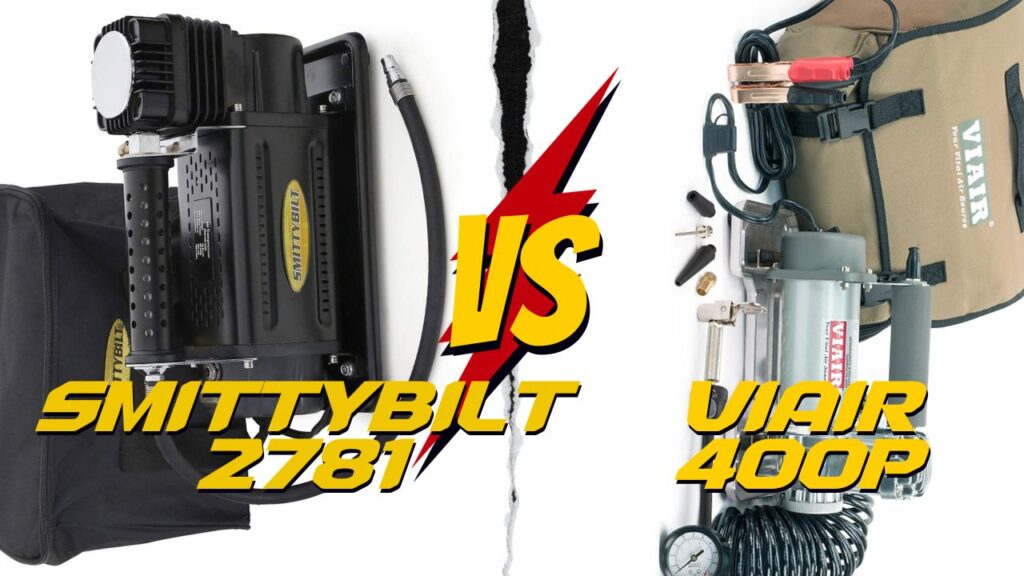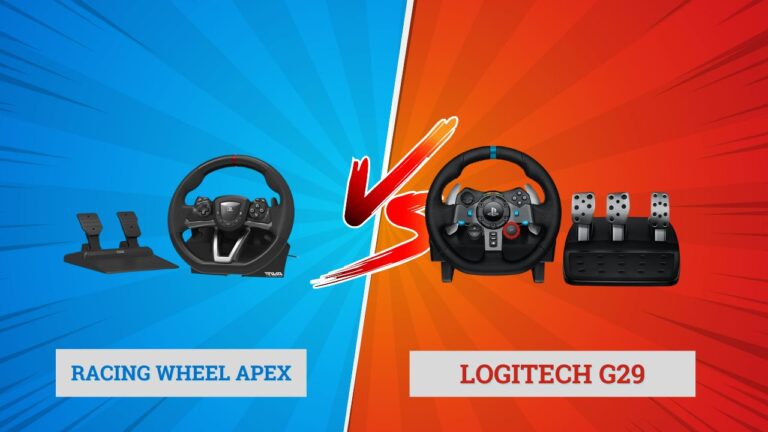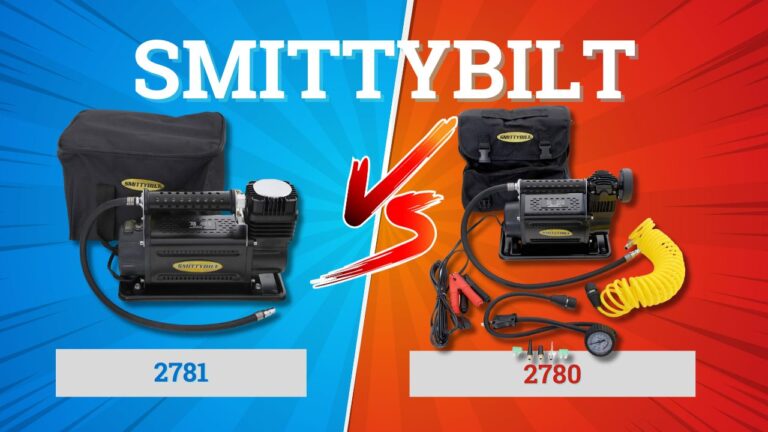In the realm of portable air compressors, few brands evoke as much respect and trust as Smittybilt and Viair. Renowned for their commitment to quality, innovation, and user-centric designs, both brands have carved unique niches in a saturated market. The portable air compressor is more than just an accessory; for many off-roaders, campers, and professionals, it’s an indispensable tool, playing a pivotal role in maintaining tire pressure, inflating camping equipment, and even running certain pneumatic tools.
Today, we set the stage for an in-depth comparison between two of their stellar offerings: the Smittybilt 2781 and the Viair 400P. While both are the product of rigorous research and advanced engineering, they cater to different audience segments, boasting features that can be deciding factors based on user needs.
Whether you’re an adventurer frequently navigating challenging terrains, a professional relying on tools in remote locations, or someone who just wants the assurance of a reliable compressor in their trunk, understanding the nuances between these two can help you make an informed decision. In this comparative review, we’ll break down their shared strengths, explore their unique characteristics, and provide a comprehensive list of pros and cons for each. So, buckle up and join us on this detailed journey to find out which compressor might just be your next trusted companion.
Shared Strengths: Common Ground
In the expansive world of portable air compressors, the Smittybilt 2781 and Viair 400P may be distinct products, but they undeniably share some solid common ground. These shared attributes are a testament to the rigorous standards both companies adhere to, ensuring that their offerings are top-tier regardless of individual product nuances.
Durability and Ruggedness
One of the foremost shared attributes is their construction quality. Constructed to weather various conditions, both the Smittybilt 2781 and Viair 400P are built with high-grade materials designed for durability. Whether you’re navigating a desert trail, trekking through a muddy forest path, or merely inflating a tire in a suburban driveway, you can rest assured these compressors won’t buckle under the pressure.
12V DC Power Source
The universality in power source compatibility is another shared boon. Both models are tailored to run on the standard 12V DC, ensuring they easily pair with most automotive power systems. This feature ensures you’re not left stranded, looking for a specific power source in remote areas.
Safety Mechanisms
Safety, often a non-negotiable for users, is well-covered by both models. Overheating is a common concern with air compressors, especially during prolonged operations. Recognizing this, both the 2781 and the 400P come integrated with overheating protection mechanisms. This feature not only extends the lifespan of the compressor but also ensures user safety during operation.
Pressure Monitoring
Accurate pressure monitoring is the linchpin of any good air compressor. Both models excel in this regard. They are equipped with precise pressure gauges, making it almost effortless to monitor and adjust inflation levels. This attention to detail mitigates the risk of potential tire damage caused by over or under-inflation, ensuring the longevity of your equipment.
Versatility in Application
While primarily known as tire inflators, both compressors aren’t limited to that singular function. Whether it’s inflating an air mattress during a camping trip, floating devices for a beach day, or even certain pneumatic tools for DIY tasks, the 2781 and 400P prove their mettle beyond just automotive needs.
Reliability in Performance
Consistent and reliable performance is a hallmark of both these models. Despite varying conditions and demands, users can expect a steady output, ensuring that the task at hand, whether it’s a quick top-up of tire pressure or a more prolonged inflation, is accomplished without hitches.
Distinct Characteristics: Drawing the Line
Even amidst shared strengths, individual products naturally emerge with unique features tailored to specific needs and demographics. Distinguishing these traits is paramount for potential buyers, as they can significantly influence purchasing decisions. As we further differentiate the Smittybilt 2781 and Viair 400P, we delve deeper into these nuances, shedding light on what makes each compressor stand apart.
Airflow Rate and Efficiency
While both compressors are designed for effective inflation, the Smittybilt 2781 edges ahead in terms of raw airflow rate. This leads to quicker inflation times, which can be crucial in situations where every second counts, such as dealing with a flat tire in adverse conditions. The Viair 400P, while robust, operates at a slightly moderated pace, prioritizing other features over sheer speed.
Maximum Pressure Output
On the other end of the spectrum, the Viair 400P emerges as the heavyweight when it comes to maximum PSI output. This heightened pressure capability means it can cater to a broader range of inflation needs, including larger tires and specialized equipment that demand higher pressure. The 2781, though efficient for most conventional tasks, may find itself outpaced in extremely high-pressure scenarios.
Portability and Design
The Viair 400P’s design ethos heavily emphasizes portability. Its compact design, combined with a lighter weight profile, makes it ideal for users who frequently shift locations or those with limited storage space. The Smittybilt 2781, though formidable, carries a bit more heft, potentially making it less suited for those who prioritize compactness.
Accessory Inclusions and Adaptability
In terms of supplementary tools and accessories, the Viair 400P is slightly more generous. Its package often includes an array of attachments and fittings, ensuring users have all they need for diverse inflation tasks right out of the box. Conversely, the Smittybilt 2781, while containing essential accessories, may not offer the same comprehensive range, urging users to occasionally seek out additional fittings.
Operational Endurance and Duty Cycle
A pivotal point of distinction is the operational endurance. Here, the Smittybilt 2781 claims the spotlight with a notably longer duty cycle, allowing it to operate for more extended periods without needing rest. This makes it a workhorse for back-to-back tasks. The Viair 400P, though resilient, leans towards shorter burst operations, potentially requiring more cooldown intervals during intensive use.
Noise and Vibration Levels
Acoustic considerations come into play when operating in quieter environments or during late hours. The Viair 400P boasts engineering tweaks that moderate noise and vibration levels, rendering it more discreet in operation. The Smittybilt 2781, while not overtly loud, tends to have a slightly more pronounced acoustic footprint during use.
User Interface and Ease of Use
Ease of operation can greatly enhance user experience. The Viair 400P incorporates a more intuitive control layout, simplifying the inflation process even for novices. The Smittybilt 2781, with its functional and utilitarian design, offers straightforward operations but might lack some of the ergonomic refinements seen in the 400P.
Smittybilt 2781:
Pros:
- Swift Airflow Rate: For quicker inflation tasks.
- Extended Duty Cycle: Suitable for longer operations.
- Economical: Generally offers good value for the price.
- Versatility: Can handle a variety of inflation needs.
Cons:
- Bulky Design: Not as portable as some competitors.
- Accessory Range: Lacks the extensive accessory variety of some counterparts.
Viair 400P:
Pros:
- High Maximum Pressure: Suitable for diverse inflation needs.
- Compactness: Ideal for those prioritizing portability.
- Accessory Suite: Rich out-of-the-box accessory inclusion.
- Renowned Brand: Viair’s pedigree ensures reliability and quality.
Cons:
- Pricey: Tends to be on the pricier side.
- Operational Breaks: Might require more breaks during extended usage compared to the 2781.
In Conclusion
The journey through the features and capabilities of both the Smittybilt 2781 and the Viair 400P underscores their individual strengths and areas of specialization. Both products emerge as champions in their own arenas. The choice between them, therefore, hinges not on objective superiority but on individual needs, preferences, and contexts of use.
The Smittybilt 2781, with its robust airflow and extended duty cycle, excels in endurance, catering especially to those requiring consistent and long-term use. Conversely, the Viair 400P, given its compactness, comprehensive accessory set, and impressive pressure range, is tailored for versatility, ideal for users who value adaptability and portability.
It’s also crucial for potential buyers to consider factors like budget and post-purchase support. While both compressors offer substantial value, it’s essential to evaluate whether one is paying for features they’ll utilize fully.
In the end, both brands reflect dedication to innovation, reliability, and user satisfaction. Whether you lean towards the resilience of the Smittybilt 2781 or the flexibility of the Viair 400P, rest assured that you’re investing in quality and performance, primed to serve your needs and enhance your experience. The final choice rests in identifying which product aligns more closely with one’s unique demands and journey ahead.




